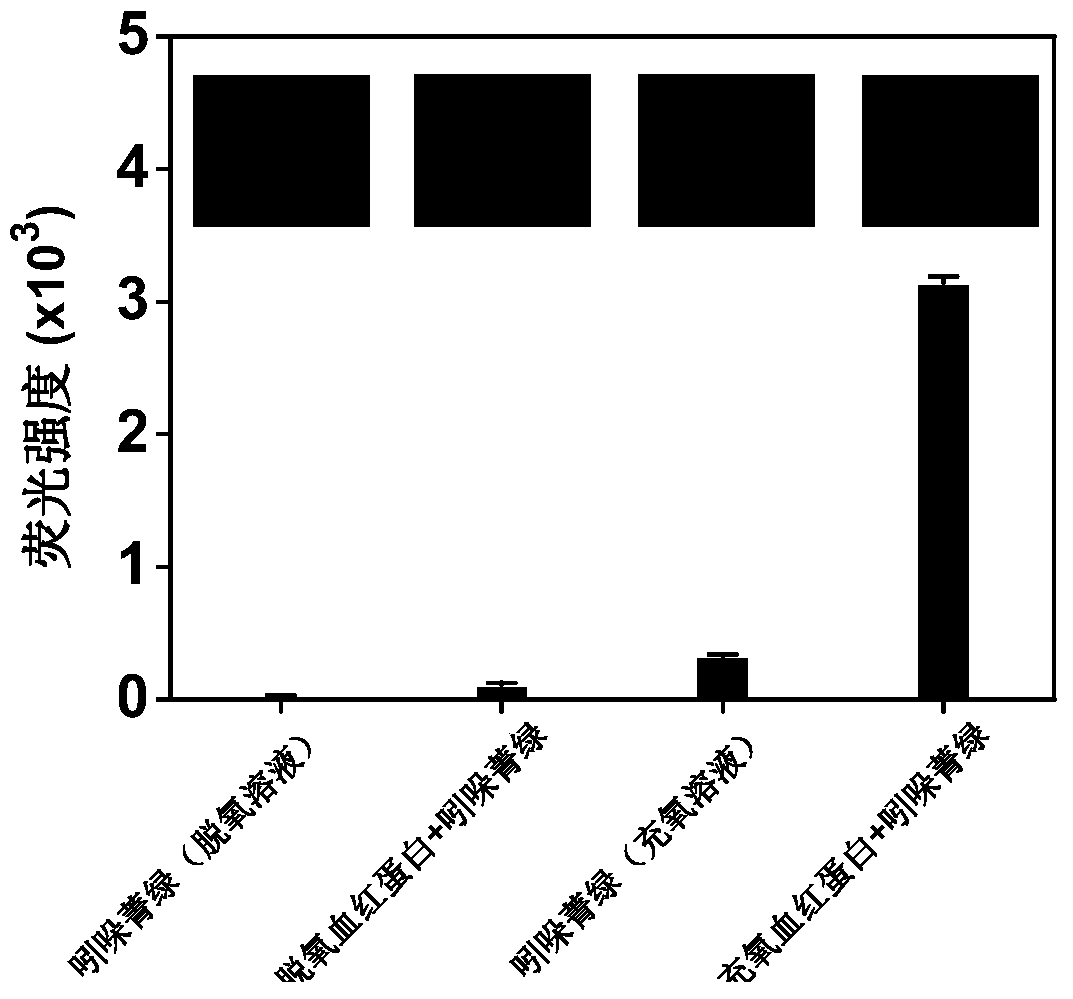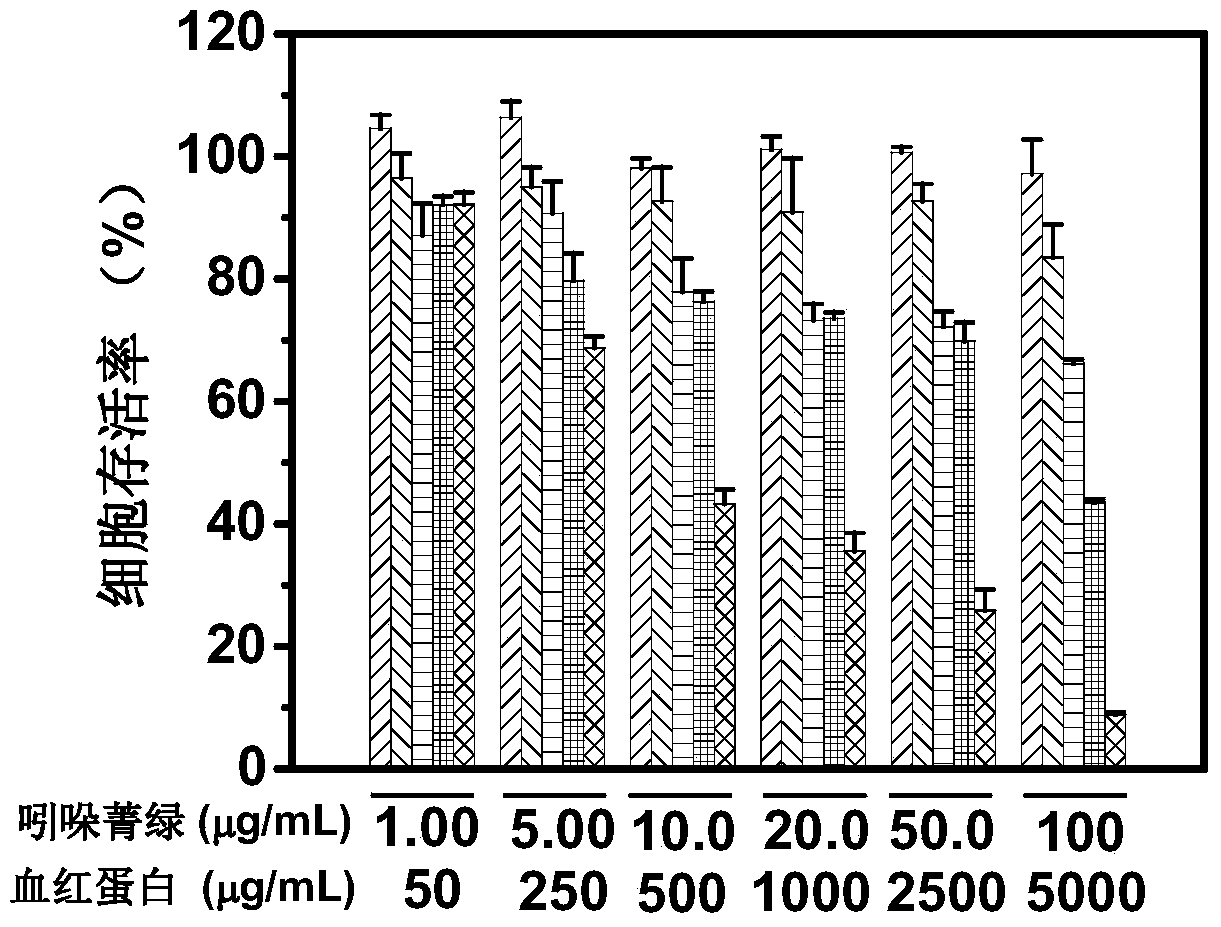Hemoglobin-photosensitizer reagent for photodynamic therapy of tumor and its application
A photodynamic therapy and hemoglobin technology, which is applied in the field of hemoglobin-photosensitizer reagents, can solve the problem that the therapeutic effect of tumor photodynamic therapy is not very satisfactory, and achieve the effects of significantly enhancing the curative effect, facilitating operation and promotion, and reducing the impact.
- Summary
- Abstract
- Description
- Claims
- Application Information
AI Technical Summary
Problems solved by technology
Method used
Image
Examples
Embodiment 1
[0041] An aqueous hemoglobin solution (5 mg / mL final concentration) was mixed with an indocyanine green solution (100 μg / mL final concentration). Pass pure oxygen into the mixed solution through the airway tube to oxygenate the hemoglobin, and the dissolved oxygen concentration in the solution reaches 35mg / L.
[0042] figure 1 Schematic diagram of computational analysis of the interaction between hemoglobin and indocyanine green molecules. The four heme molecules in hemoglobin can carry oxygen. According to the calculation and analysis of biomolecules, after the indocyanine green molecule is non-covalently combined with the hemoglobin molecule, the distances from the four oxygen-carrying sites are 17.3, 18.4, 21.3, and 25.4, respectively. Angstrom, the oxygen molecule is very close to the photosensitizer molecule, and the utilization rate of oxygen in the photodynamic reaction is improved.
[0043]Add the oxygenated hemoglobin-indocyanine green mixed solution (the concentrat...
Embodiment 2
[0046] MCF-7 tumor cells were inoculated overnight in a 96-well plate at a density of 5000 cells / well, and oxygenated hemoglobin (final concentration was 5 mg / mL, oxygenated to a dissolved oxygen amount above 30 mg / L) and indocyanine green (final Concentration of 100 μg / mL) mixed solution to replace the cell culture medium, incubate for 30 minutes, and then adjust the power and focus of the 808nm laser to make the light spot at 0.1W / cm 2 The power density irradiates the tumor area for 5 minutes for treatment. After the treatment, the cells were cultured for 24 hours, and the cell viability was analyzed.
[0047] For experimental results, see image 3 As shown, the groups from left to right in the figure are: untreated hemoglobin + indocyanine green (this group is a no-light group, and the following four groups are all treated with laser irradiation), indocyanine green (deoxygenated solution), deoxygenated Hemoglobin + indocyanine green, indocyanine green (oxygenated solution...
Embodiment 3
[0049] Inoculate MCF-7 tumor cells on the dorsal side of nude mice, when the transplanted tumor grows to a volume of 100mm 3 120 μL of a mixed solution of hemoglobin (final concentration: 15 mg / mL) and indocyanine green (final concentration: 500 μg / mL) was injected into the tumor, and 808 nm By adjusting the power and focus of the laser, the light spot can be adjusted at 0.1W / cm 2 The power density was irradiated to the tumor area for 30 minutes.
[0050] Figure 4 Cell necrosis analysis shown for enhanced photodynamic therapy with oxygenated hemoglobin. According to the observation of the treated nude mice, 6 days after the treatment, the tumor area was necrotic and scabbed, and the tumor growth was significantly inhibited.
PUM
| Property | Measurement | Unit |
|---|---|---|
| wavelength | aaaaa | aaaaa |
Abstract
Description
Claims
Application Information
 Login to View More
Login to View More - R&D
- Intellectual Property
- Life Sciences
- Materials
- Tech Scout
- Unparalleled Data Quality
- Higher Quality Content
- 60% Fewer Hallucinations
Browse by: Latest US Patents, China's latest patents, Technical Efficacy Thesaurus, Application Domain, Technology Topic, Popular Technical Reports.
© 2025 PatSnap. All rights reserved.Legal|Privacy policy|Modern Slavery Act Transparency Statement|Sitemap|About US| Contact US: help@patsnap.com



